Cosmetic Prosthetics Market Size and Trends
The Cosmetic Prosthetics Market is estimated to be valued at USD 1.31 Bn in 2025 and is expected to reach USD 2.04 Bn by 2032, exhibiting a compound annual growth rate (CAGR) of 6.5% from 2025 to 2032.
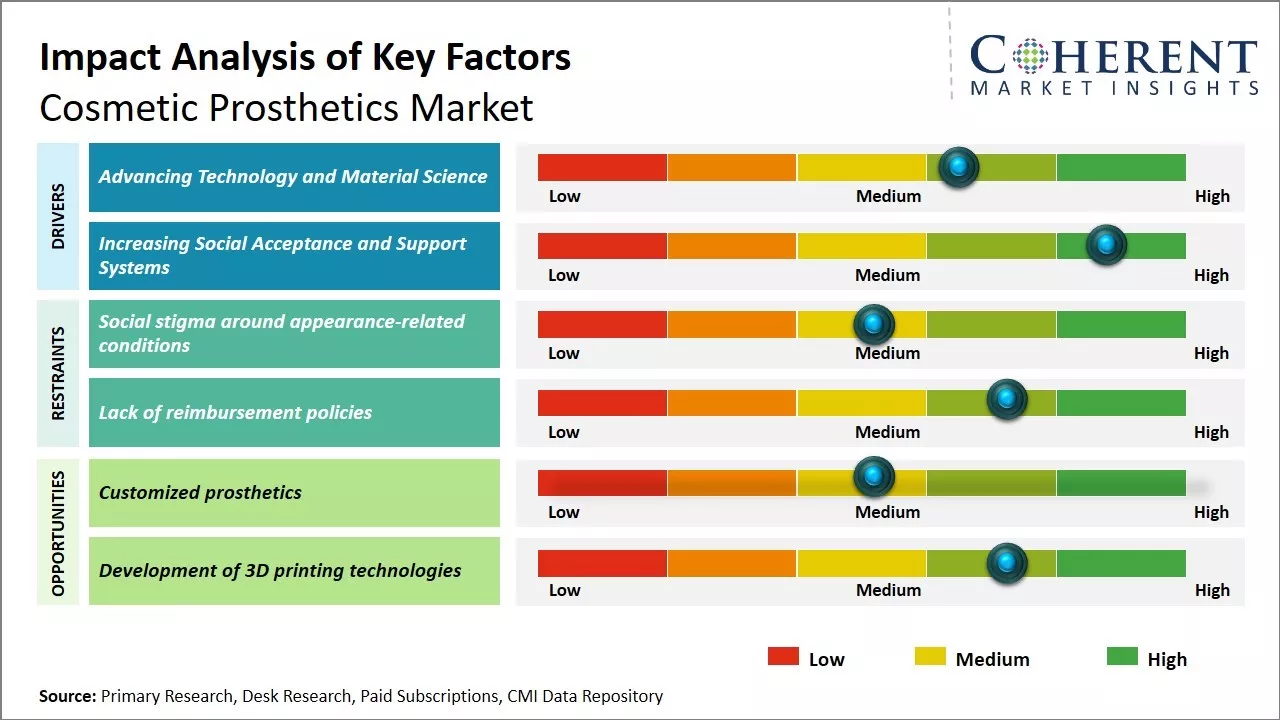
Discover market dynamics shaping the industry: Download Free Sample
The demand for cosmetic prosthetics is expected to grow steadily during the forecast period. Rising incidence of accidents and trauma injuries globally are expected to increase the demand for reconstructive and cosmetic surgeries.
Furthermore, growing awareness about physical appearance and aesthetic surgeries among people are contributing to the market growth. Advancements in technology such as digitization, 3D printing, and computer-assisted design and manufacturing are helping surgeons provide prosthetics that look more natural. This is bolstering confidence among consumers and in turn driving the demand for innovative and realistic cosmetic prosthetics. Marketing and promotion by manufacturers through web portals, journals, and conferences are creating more awareness about the availability of prosthetics for improved physical appearance.
Advancing Technology and Material Science
The rising sophistication in material science and 3D printing technology has enabled the development of highly realistic and comfortable prosthetic devices for the cosmetic industry. Advanced materials that closely mimic human skin textures, flexibility and resilience are helping prosthetics blend in seamlessly. 3D scanning and 3D printing allow for precise customization of prosthetics to individual shapes and sizes. Software advancements in designing, digital mapping, and color matching have augmented the aesthetic outcomes. Implant grade materials are making prosthetics durable and longer lasting. These innovations are elevating the standards of realism, aesthetics, and wearer comfort. As the technology gap between natural and artificial continues to shrink, more individuals are finding prosthetics an attractive option instead of concealment.
Market Concentration and Competitive Landscape
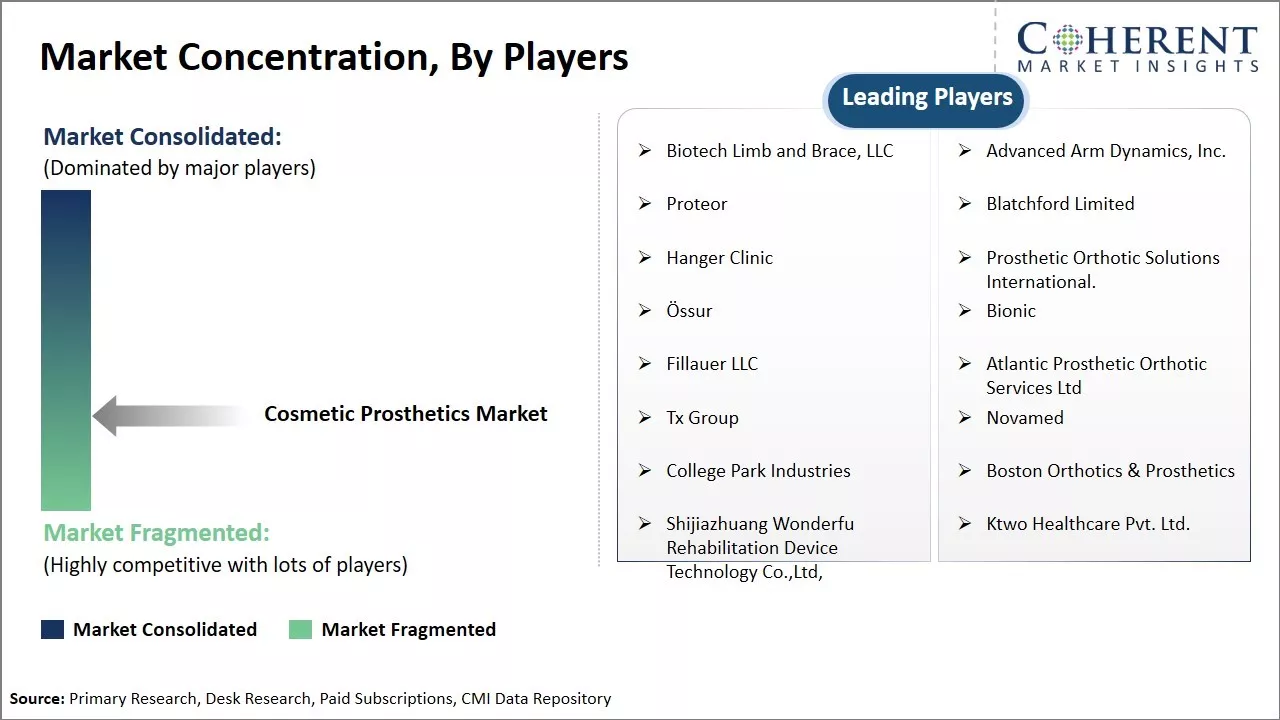
Get actionable strategies to beat competition: Download Free Sample
Increasing Social Acceptance and Support SystemsThere is a rising social consciousness that physical impairments or disfigurements do not undermine one's personality or capabilities. Numerous advocacy groups promote the message of empowerment, self-esteem and dignity through prosthetics usage. Similarly, media representation of accomplished individuals with prosthesis continues to nurture positivity. This shift in perception makes people comfortable about their prosthetic usage in all spheres including personal, social and professional domains. Peer communities provide education and emotional support during pre and post prosthetic adaptation phases. Government schemes in some countries financially support qualifying individuals. For example, health insurance may cover part of the cost for prosthetics prescribed for medical conditions.
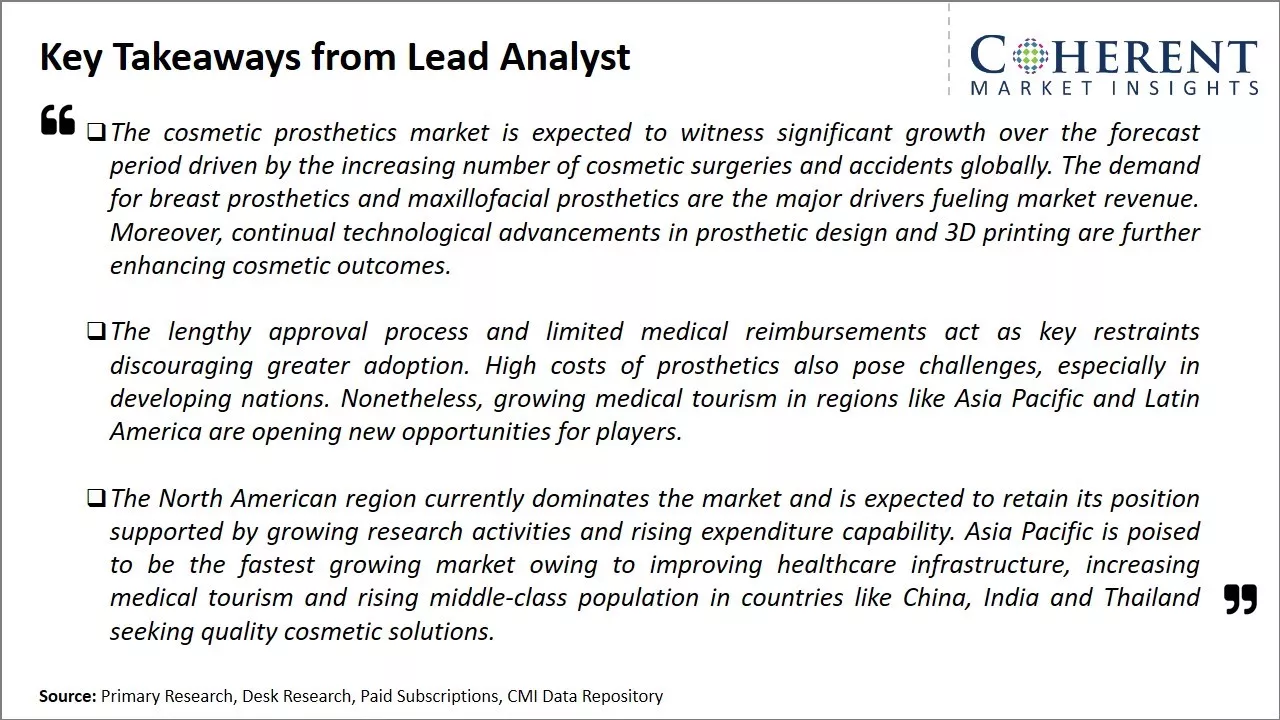
To learn more about this report, Download Free Sample
Market Challenges – Social stigma around appearance-related conditions:The cosmetic prosthetics market faces several challenges. Due to the social stigma around appearance-related conditions, many patients are reluctant to seek treatment. High costs also present a barrier, as prosthetics can be expensive and are often not fully covered by insurance. Additionally, developing technologically advanced prosthetics that are lightweight, comfortable and closely resemble natural features remains technically challenging. Ensuring prosthetics hold up over the long term with daily use and motions like smiling or frowning continues to be an area needing further innovation.
Market Opportunities – Customized prosthetics:
There are substantial opportunities for growth in the cosmetic prosthetics market. An aging population means more individuals will seek treatments for conditions like breast cancer. Advances in 3D printing and customized modeling allow for highly precise, personalized prosthetics. As social acceptance increases, more patients will elect for cosmetic options rather than function-only devices.
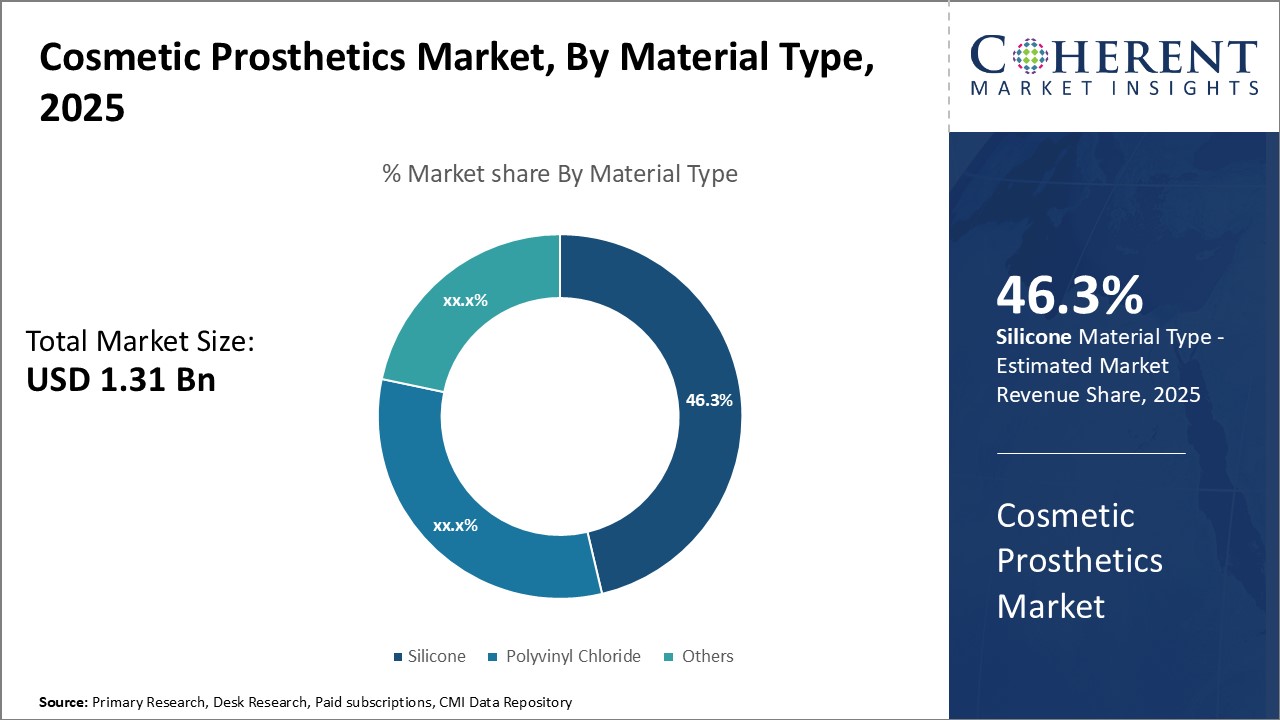
Discover high revenue pocket segments and roadmap to it: Download Free Sample
Insights, By Material Type: Superior Properties Drive Silicone DominanceThe material type segment includes silicone, polyvinyl chloride (PVC), and others. In terms of Material Type, the Silicone segment is anticipated to hold 46.3% of the market share in 2025, owing to its superior properties over other materials. Silicone is very lightweight and flexible, allowing prosthetics made from it to feel very natural. Its elastic and durable nature ensures prosthetics maintain their shape and do not crack or wear out easily over time. This translates to greater comfort for users. Silicone is also waterproof and does not degrade when exposed to moisture from sweat or bathing. This makes silicone prosthetics fully functional for all activities of daily living. Their water resistance prevents damage and prolongs the usable life of the prosthetic. This translates to cost savings over time versus replacements.
Insights, By Product: Freedom of Motion Boosts Upper Limb Dominance
The product type segment includes upper limb prosthetics, lower limb prosthetics, facial prosthetics, and others. In terms of product type, the Upper Limb Prosthetics segment is expected to hold the highest share of the market i.e., 39.4% in 2025. Upper limb prosthetics aim to restore lost capabilities of the hand, wrist, arm and shoulder. These critical functions allow users to resume many activities of daily living independently. Advanced designs closely mimic the intricate workings of biological joints like the wrist, knuckles and fingers. State-of-the-art myoelectric prosthetics read electrical signals from residual muscles to power highly dexterous movement. This level of functionality provides finer motor skills that approach natural ability.
Insights, By End User: Specialization Drives Preference for Prosthetic Clinics
The end user segment includes prosthetic clinics, hospitals, and others. In terms of End User, the Prosthetic Clinics segment is anticipated to lead the market growth and hold 46.4% of the market share in 2025. Certified prosthetists within clinics have extensive expertise in fabrication, fitting, and training surrounding prosthetic devices. Their specialized facilities have dedicated amenities and expertise not commonly available at general hospitals. Prosthetic clinics can offer customized devices tailored precisely to individual anatomical needs, activity levels and cosmetic preferences. Certified prosthetists are able to spend more time on fittings, gait training, and device adjustment compared to hospitals with larger patient loads and administrative duties. Their focused care helps clients maximize functionality from their devices for improved quality of life.
Regional Insights
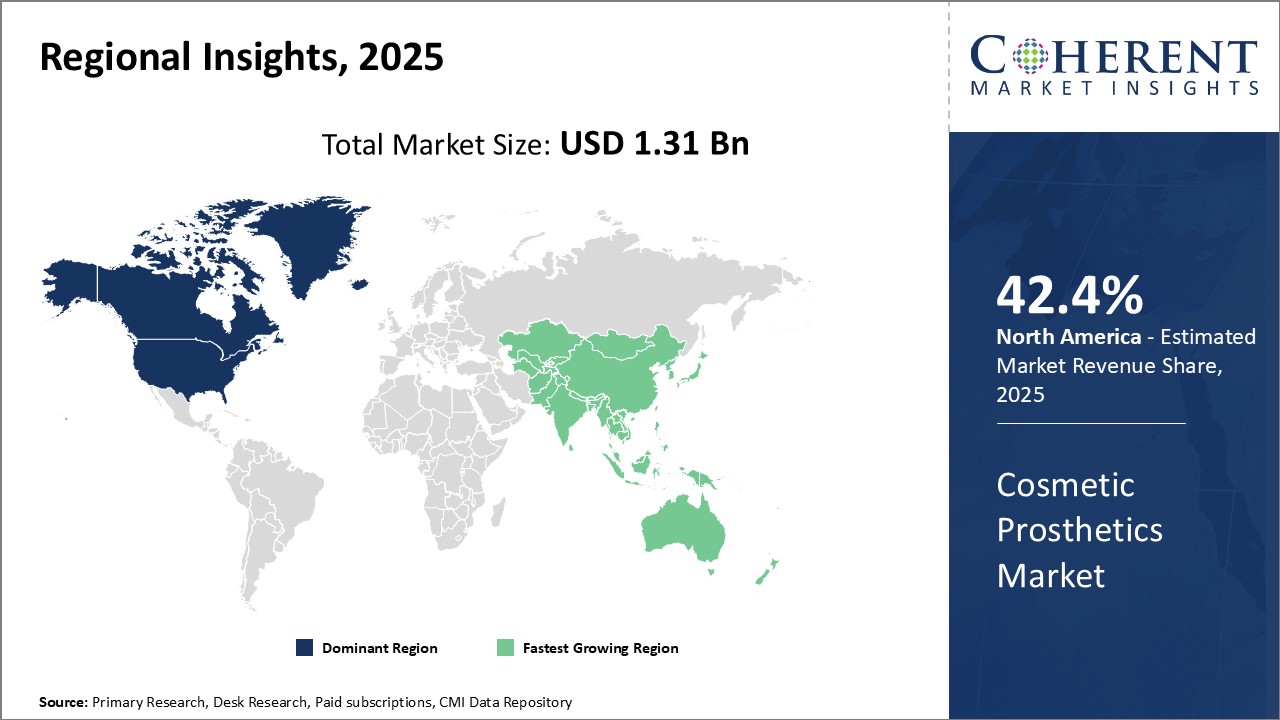
Need a Different Region or Segment? Download Free Sample
North America has been and is anticipated to be the dominant regional market for cosmetic prosthetics and hold 42.4% of the market share in 2025. The large size and high spending power of the U.S. healthcare market has allowed for significant investment in R&D by leading manufacturers. As a result, North America is home to many innovation leaders in advanced materials and 3D printing technologies for prosthetics. Several manufacturers have their global headquarters and main production facilities located in the U.S. and Canada to cater to local demand as well as exports worldwide. This strong manufacturing and technology base has ensured that North America leads globally in terms of the variety and quality of products offered. Leading manufacturers routinely launch new collections in cosmetic prosthetics catering to the evolving needs of the vast patient pool in the region.
The Asia Pacific region has emerged as the fastest growing market for cosmetic prosthetics globally. Countries such as China, Japan, South Korea, and India represent massive untapped opportunities given their large population sizes and growing medical expenditures. While pricing continues to remain relatively lower than developed markets currently, volumes are rising sharply. The Asia Pacific market is expected to keep expanding rapidly driven by factors such as increasing healthcare access, greater awareness and improving medical infrastructure across emerging economies.
Market Report Scope
Cosmetic Prosthetics Market Report Coverage
| Report Coverage | Details | ||
|---|---|---|---|
| Base Year: | 2024 | Market Size in 2025: | USD 1.31 Bn |
| Historical Data for: | 2020 To 2024 | Forecast Period: | 2025 To 2032 |
| Forecast Period 2025 to 2032 CAGR: | 6.5% | 2032 Value Projection: | USD 2.04 Bn |
| Geographies covered: |
|
||
| Segments covered: |
|
||
| Companies covered: |
Biotech Limb and Brace, LLC, Advanced Arm Dynamics, Inc., Proteor, Blatchford Limited, Hanger, Inc., Prosthetic Orthotic Solutions International., Össur, Bionic, Fillauer LLC, Atlantic Prosthetic Orthotic Services Ltd, Tx Group, Novamed, College Park Industries, Boston Orthotics & Prosthetics, Shijiazhuang Wonderfu Rehabilitation Device Technology Co.,Ltd, and Ktwo Healthcare Pvt. Ltd. |
||
| Growth Drivers: |
|
||
| Restraints & Challenges: |
|
||
Uncover macros and micros vetted on 75+ parameters: Get instant access to report
Cosmetic Prosthetics Industry News
- On February 22, 2024, Hanger Inc., a U.S.-based provider of orthotics and prosthetic care services with 900 clinics nationwide, announced the acquisition of Fillauer LLC, a medical device manufacturer, to expand its fabrication and production of prosthetic devices. With this acquisition Hanger Inc. will bolster its manufacturing capabilities and increase its market penetration in orthotic and prosthetic ecosystem
*Definition:The cosmetic prosthetics market covers medical devices used to aesthetically restore parts of the body affected by trauma, disease, or congenital conditions. It includes implants and artificial body parts designed to look like natural body tissues and improve psychological well-being through restored physical appearance. Some examples are facial implants, mammary implants, penile and testicular prosthetics, scalp replacement, and artificial nipples and ears. These prosthetics aim to meet both medical and cosmetic needs of patients.
Market Segmentation
- Material Type Insights (Revenue, USD BN, 2020 - 2032)
- Silicone
- Polyvinyl Chloride (PVC)
- Others
- Product Insights (Revenue, USD BN, 2020 - 2032)
- Upper Limb Prosthetics
- Lower Limb Prosthetics
- Facial Prosthetics
- Others
- End User Insights (Revenue, USD BN, 2020 - 2032)
- Prosthetic Clinics
- Hospitals
- Others
- Regional Insights (Revenue, USD BN, 2020 - 2032)
- North America
- U.S.
- Canada
- Latin America
- Brazil
- Argentina
- Mexico
- Rest of Latin America
- Europe
- Germany
- U.K.
- Spain
- France
- Italy
- Russia
- Rest of Europe
- Asia Pacific
- China
- India
- Japan
- Australia
- South Korea
- ASEAN
- Rest of Asia Pacific
- Middle East
- GCC Countries
- Israel
- Rest of Middle East
- Africa
- South Africa
- North Africa
- Central Africa
- North America
- Key Players Insights
- Biotech Limb and Brace, LLC
- Advanced Arm Dynamics, Inc.
- Proteor
- Blatchford Limited
- Hanger, Inc.
- Prosthetic Orthotic Solutions International.
- Össur
- Bionic
- Fillauer LLC
- Atlantic Prosthetic Orthotic Services Ltd
- Tx Group
- Novamed
- College Park Industries
- Boston Orthotics & Prosthetics
- Shijiazhuang Wonderfu Rehabilitation Device Technology Co.,Ltd,
- Ktwo Healthcare Pvt. Ltd.
Share
Share
About Author
Komal Dighe is a Management Consultant with over 8 years of experience in market research and consulting. She excels in managing and delivering high-quality insights and solutions in Health-tech Consulting reports. Her expertise encompasses conducting both primary and secondary research, effectively addressing client requirements, and excelling in market estimation and forecast. Her comprehensive approach ensures that clients receive thorough and accurate analyses, enabling them to make informed decisions and capitalize on market opportunities.
Missing comfort of reading report in your local language? Find your preferred language :
Transform your Strategy with Exclusive Trending Reports :
Frequently Asked Questions
EXISTING CLIENTELE
Joining thousands of companies around the world committed to making the Excellent Business Solutions.
View All Our Clients
